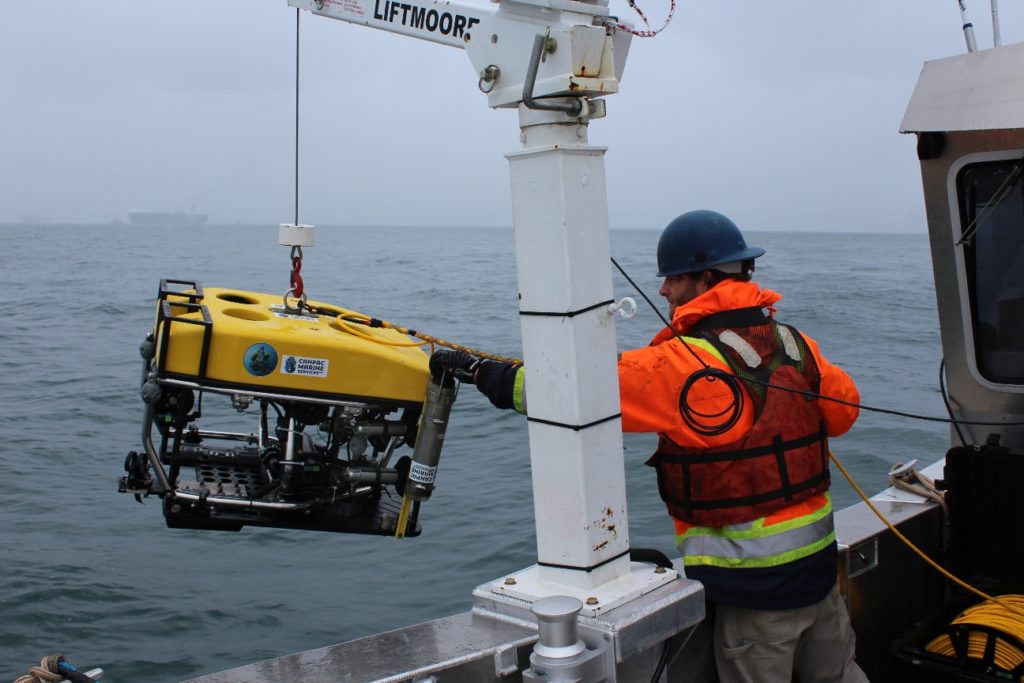NANAIMO, BRITISH COLUMBIA, July 22, 2020 – Commercial diving contractor CanPac Marine Services used the SEAMOR Mako ROV to monitor conditions and assist CanPac’s dive team as it replaced damaged diffusers on a stormwater outfall in a high current area offshore of Victoria, British Columbia, at a depth of 60 meters (200 feet).
“The depth and current created challenging conditions for the CanPac team, but the Mako ROV allowed the diving supervisor to survey the site beforehand then closely monitor the divers during the repair operation,” said Mr. Robin Li, President of SEAMOR Marine. “The Mako can cover lots of ground, ascending and descending without issue even in current, to look at different angles.”
CanPac’s diving supervisor used the Mako to check the condition of the work site and scan for any potential hazards before deploying the dive team. The Mako also helped identify areas to focus on ahead of time so that divers could address them more directly.
During the operation, the Mako served as a second set of eyes enabling the supervisor to monitor the divers and the worksite in real time to safely manage any developing hazardous situations. In the event of an emergency, the supervisor could have used the Mako to oversee and control the rescue of a diver.
“Our Mako ROV once again proved to be an extremely valuable asset enhancing our productivity and safety during this project.” said Ryan Anderson, Director of Operations at CanPac Marine Services. “We chose the Mako for this project mainly because of its proven efficiency in high current.”
High current can jeopardize safety in a commercial diving situation, but the Mako ROV was designed to mitigate the risk.
“The Mako runs on DC power supplied from the surface,” says Li. “Other vehicles of the same size run AC power directly to the vehicle, which could pose a significant risk to the divers if they come in contact with stray current.”
CanPac, with a spotless safety record over its 40+ years of operations, has used the Mako ROV for dozens of inspections over the last months.
“It’s a versatile, reliable workhorse that can handle a heavy payload and operate in challenging conditions,” said Anderson. “It does the job that we’ve had to use much larger work class ROVs for in the past, and it has resulted in a considerable cost savings for us and our clients.”
The Mako ROV is the company’s largest ROV and can support a payload of up to 22.5 kilograms (50 pounds), working in depths up to 600 meters (2,000 feet). The Chinook is the mid-sized vehicle in SEAMOR’s line of ROVs, able to dive to 600 meters (2,000 feet). The Steelhead ROV, SEAMOR’s smallest vehicle, is more compact and suited for work in confined spaces in depths of up to 300 meters (1,000 feet).
Based in Nanaimo, British Columbia on Vancouver Island on Canada’s west coast, SEAMOR Marine Ltd. designs and manufactures underwater observation and inspection-class remotely operated vehicles (ROVs) and modular accessories. SEAMOR sells worldwide and has ROVs operating on every continent and in every major body of water around the globe. The company’s ROVs have been used in a variety of fields including aquaculture, underwater archaeology, Antarctic geology, and pipeline and dam inspection. SEAMOR has collaborated on research projects with NASA, Defence Research and Development Canada, and the Department of Fisheries and Oceans.
– 30 –
Photo credit: SEAMOR Marine
These images are the property of SEAMOR Marine Ltd. and may be used/reprinted in association with this news story. Any other request to use these images must be sent to SEAMOR Marine Ltd. prior to publishing.
Media contacts
Mr. Robin Li (President)
Email: rli@seamor.com
Phone: 1 (250) 729-8899
Mr. Simon Douthwaite (Sales and Marketing Manager)
Email: sdouthwaite@seamor.com
Website: www.seamor.com

